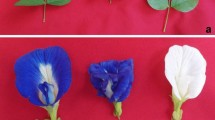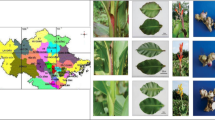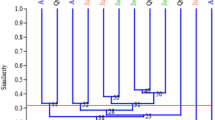Abstract
Calotropis procera (Aiton) W. T. Aiton. (family: Asclepiadaceae) is an important medicinal shrub distributed in the tropical and subtropical regions of the world. In Egypt, it is distributed throughout different phytogeographical regions. Genetic analyses were performed to study polymorphism of 18 individual genotypes collected from six different localities across Egypt (Aswan, New Valley, Cairo-Suez road, Feran, Nuweibaa, and Arish), and to elucidate their population genetic relationships. Five Operon primers successfully generated reproducible polymorphic products. RAPD profiles revealed high levels of polymorphism for the studied individual genotypes (93.45 %). Both number and size of the amplified products varied considerably with different primers and a sum of 100 polymorphic and 7 monomorphic bands were generated in all the individuals under study. A total of 24 unique bands were also identified. The combination of all polymorphic bands generated by all five primers was enough to discriminate between the six different localities. The dendrogram constructed revealed that Aswan (south Nile Valley) and Feran valley (South Sinai mountain area) to be separated in two distinct clusters, while the other four localities in a third cluster. Similarity indices for the genetic distances showed that the highest similarity was (76.03 %) between the genotypes from Cairo-Suez road and Nuweibaa regions, while the lowest was between Feran and Nuweibaa genotypes (63.87 %). The study confirmed the high polymorphic nature of the species and showed that genotypes of the Aswan locality have a highly similar gene pool to genotypes of most localities. South Sinai Feran locality seems to be of a different genetic background. Future studies on material collected from other phytogeographical regions of the world, as well as, using other molecular marker techniques, will contribute to understanding of the species polymorphism and its phytogeographical relationships across different regions of the world.



Similar content being viewed by others
References
Abd El-Wahab RH, Zaghloul MS, Kamel WM, Moustafa AA (2008) Diversity and distribution of medicinal plants in North Sinai. Egypt Afr J Environ Sci Technol 2:157–171
Abo El-Kheir ZA, El-Fiki FA, Abd El-Kawy AM (2007) Some genetic and molecular studies on Calotropis procera. Egypt J Bot 47:17–36
Amritphale D, Gupta J, Iyengar S (1983) Germination polymorphism in sympatric populations of Calotropis procera. Oikos 42:220–224
Batanouny KH (1999) Wild medicinal plants in Egypt. The Palm Press, Egypt, pp 128–129
Bekhit MM, El-Shawaf IS, Hassan AM, El-Saied FM, Masoud IM (2008) Genetic distances between three Ushaar (Calotropis procera (Ait)f.) genotypes as measured by RAPD and ISSR techniques. The fourth conference of sustainable agricultural development, Benha University, Egypt
Bhatnagar S (1975) Floral polymorphism in sympatric populations of Calotropis procera (Ait.) R. Br. Acta Bot Indica 3:43–46
Boulos L (2000) Flora of Egypt, vol 2. Al-Hadara Publishing, Cairo, pp 212–222
Boulos L (2009) Flora of Egypt. Checklist revised annotated edition. Al-Hadara Publishing, Cairo, pp 168–169
El Hadidi MN (2000) Geomorphology, climate and phytogeographical affinities. In: El Hadidi MN (ed) Flora Aegyptiaca, vol 1. The Palm Press, Cairo, pp 1–45
El-Fiki FA, Abo El-Kheir ZA, Abd El-Kawy AM (2007) Development of tracheary elements and laticifer in callus of Calotropis procera plant. Egypt J Genet Cytol 36:25–42
Fleurentin J, Pelt JM (1982) Repertory of drugs and medicinal plants of Yemen. J Ethnopharmacol 5:85–108
Forster PI (1998) A taxonomic account of the genus Calotropis R.Br. (Asclepiadaceae) in Australia. Nuytsia 8:201–208
Hemaida SK, Abdel-Razeq NA (2002) Studies on mosaic virus of cucumber in Assiut Bulletin of the Faculty of Science Assiut University. Botany 31:113–121
Jain SC, Sharma R, Kain R, Shanna RA (1996) Anti-microbial activity of Calotropis procera. Fitoterapia 67:275–277
Kruscal JB (1964) Non-metric multidimensional scaling a numerical method. Psychometrika 29:115–129
Mahmood T, Tariq A, Nazar N, Abbasi BH, Naqvi SM (2011) Comparative assessment of genetic variability in Cryptolepis buchananli, Tylophora hirsuta and Wattakaka volubilis. Pak J Bot 43:2295–2300
Mehrnia M, Shahin Z, Ashraf S (2005) Intra- and inter-specific relationships within the Astragalus microcephalus complex (Fabaceae) using RAPD. Biochem Syst Ecol 33:149–158
Mohanraj R, Rakshit J, Nobre M (2010) Anti HIV-1 and antimicrobial activity of the leaf extracts of Calotropis procera. Int J Green Pharm 4:242–246
Nosrati H, Husainpourfeizi MA, Khorasani M, Razban-Haghighi A, Nikniazi M (2012) Sex ratio and genetic diversity in the dioecious Pistacia atlantica (Anacardiaceae). J Agrobiol 29:41–46
Orwa C, Mutua A, Kindt R, Jamnadass R, Simons A (2009) Agroforestree database: a tree reference and selection guide version 4.0 (http://www.worldagroforestry.org/af/treedb/)
Sharma P, Sharma JD (1999) Evaluation of in vitro schizontocidal activity of plant parts of Calotropis procera an ethnobotanical approach. J Ethnopharmacol 15:83–95
Sultan P, Shawl AS, Rehman S, Fayaz S, Ramteke PW (2010) Molecular characterization and marker based chemotaxonomic studies of Podophyllum hexandrum Royle. Fitoterapia 81:243–247
Vajha M, Audipudi AV, Murthy KSR (2011) DNA fingerprinting profile of Caralluma species: an approach to molecular taxonomy. Asian J Biochem Pharm Res 1:500–506
Verma DR, Kakkar A, Bais N, Dubey P (2011) Antifungal activity of Calotropis procera. J Glob Pharm Tech 3:11–14
Williams JG, Kubelk AR, Livak KJ, Rafalski JA, Tingey SV (1990) DNA polymorphisms amplified by arbitrary primers are useful as genetic markers. Nucleic Acids Res 18:6531–6535
Zahran M, Willis JE (1992) The vegetation of Egypt. Chapman and Hall, London
Acknowledgments
The research was funded by Grant #79 from the Academy of Scientific Research and Technology, Egypt, to whom the authors are grateful. We also wish to thank the Science and Technology Development Fund (Project #279) for providing the financial support for the work on the Sinai samples. The help of Dr. Tarek Galal, Botany Department, Helwan University, with the statistical analysis is greatly appreciated.
Author information
Authors and Affiliations
Corresponding author
Rights and permissions
About this article
Cite this article
El-Bakry, A.A., Hammad, I.A. & Rafat, F.A. Polymorphism in Calotropis procera: preliminary genetic variation in plants from different phytogeographical regions of Egypt. Rend. Fis. Acc. Lincei 25, 471–477 (2014). https://doi.org/10.1007/s12210-014-0316-y
Received:
Accepted:
Published:
Issue Date:
DOI: https://doi.org/10.1007/s12210-014-0316-y




